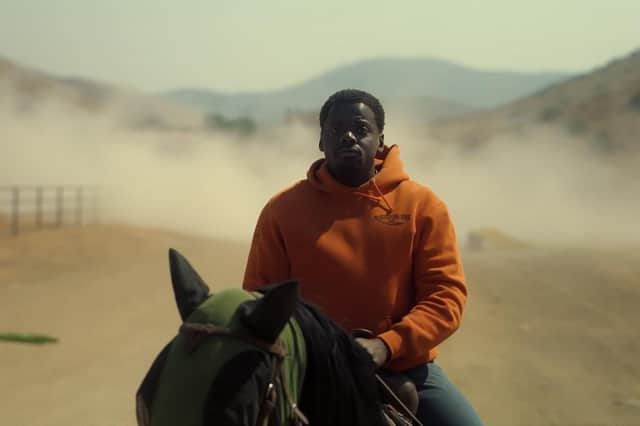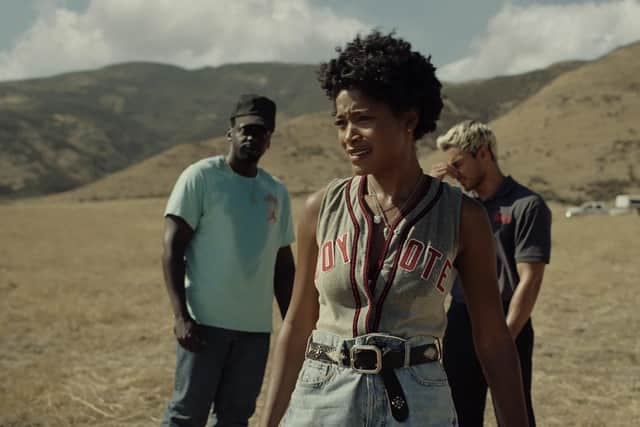Film reviews: Nope | Where is Anne Frank


Nope (15) ****
Where is Anne Frank (PG) ****
Nope, the latest film from Jordan Peele, begins with a scene that could have come out of a particularly brutal prequel to The Planet of the Apes. It’s the late 1990s and a sitcom about a family with a pet chimp turns bloody on set when its primate star attacks the cast. We see almost nothing, but the implicit revolt of an exploited animal offers something of a clue to the larger themes teased out by Peele as he mashes together several genres within a Twilight Zone-esque premise set on the fringes of the movie industry.
That setting isn’t random either. After the garbled Us saw Peele struggle to weave a multitude of provocative ideas into a half-way coherent story, Nope seems intent on taking us on a full-blown cinematic ride, one with an intriguing meta quality that pulls the curtain back on the cost such rides sometimes entail.
Advertisement
Hide AdReuniting with Peele for the first time since Get Out, Oscar-winner Daniel Kaluuya stars as OJ Haywood, the proprietor of a ranch and horse-wrangling business that he’s recently inherited from his father (Keith David). Along with his sister, Emerald (Keke Palmer), they supply horses for films, TV shows and commercials, but as the film opens, the business is struggling and there have been weird goings-on at the ranch, starting with their father’s mysterious death six months earlier and continuing with power outages and disappearing livestock. Then there’s the strange light show coming from the neighbouring ranch, a Wild West theme park run by Steven Yeun’s Ricky “Jupe” Parks, a former child star with a twisted backstory all his own.
If this sounds cryptic that’s partly the design of the movie, even if the trailer gives away a chunk of the puzzle by revealing the specific sub-genre Nope is operating in. No spoilers here, but that’s also a bit of a ruse since Nope’s success doesn’t hinge on keeping its first big reveal a secret. Indeed the goofy jump-scares and jokey dialogue that initially seem to let the air out of the film after the wonderfully creepy opening act starts to feel more like a way for Peele to acknowledge his concept's more shopworn aspects so he can skip past all the obvious comparisons to Spielberg and M Night Shyamalan and get on with telling the story he wants to tell.
Just what that story is is a little harder to nail down. It builds up an impressive head of steam as an increasingly tense sci-fi horror spectacle, but it also seems to be a movie about the power of looking and, especially, the power a camera has to both capture reality and erase it. Again and again Peele draws attention to cameras – surveillance cameras, phone cameras, movie cameras – and Nope’s second half revolves around the characters’ own attempts to document the mystery at its heart on film, an endeavour fraught with violence and danger and involving the arrival of a maverick cinematographer who has echoes of Werner Herzog at his most obsessive (he’s played by Michael Wincott).


What they’re chasing has a camera-like aspect to its design too (all credit to Peele and his team for really subverting genre conventions here) and we soon learn that looks can literally kill in this world. But as you might expect from the director of Get Out, Peele also broadens this into a meditation on race in America, and more specifically Hollywood’s treatment of race on film. Early on, Emerald explains to the disinterested crew of a commercial that her and OJ's family business was inspired by an ancestor whom she claims was the Black jockey in what’s thought to be the first example of a moving image ever created. It’s a claim that’s hard to dispute because in reality the name of said jockey was never recorded, effectively erasing him from his rightful place in the history books and setting a precedent for the way Black stories, Black faces and Black culture would be eradicated or misrepresented in the industry going forth.
What follows isn’t some didactic message movie, though, but a sly revolt against the oppressiveness of that history. Peele has brilliantly repurposed the iconography of some of Hollywood’s most beloved genres to create a broad-appeal blockbuster with a different point of view. Movies can look like this too, Nope seems to be saying. Get used to it.
As you might expect from a film entitled Where is Anne Frank, oppression is also one of the big themes running through this intriguing animated retelling of the Anne Frank story. Directed by Waltz with Bashir's Ari Folman, and pitched at YA audiences, it’s built around a fantastical conceit in which Kitty – the imaginary friend to whom Anne addressed her diary – comes to life, steals the diary and ends up wandering around modern day Amsterdam oblivious to Anne's fate. What she finds instead is a city where refugees are being denied sanctuary yet Anne is deified, something Folman uses to make blunt but effective points about the lessons of her young life being forgotten by an adult world too concerned with her value as a tourist attraction.
Both films are on general release from 12 August